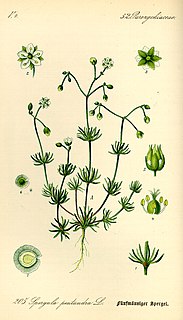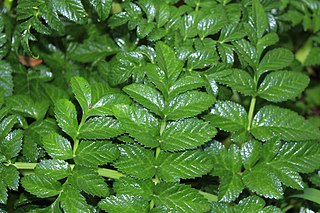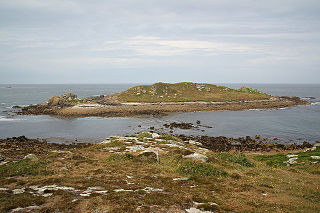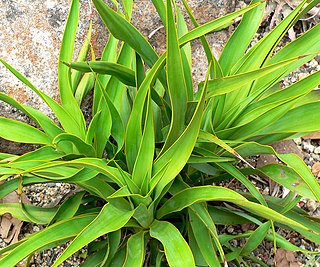
Spergula is a genus of flowering plants in the family Caryophyllaceae. Their usual English name is spurry or spurrey. Commonly found in grassland, the genus originated in the northern hemisphere, but is now found worldwide.
This article gives an overview of the maritime cliff communities in the British National Vegetation Classification system.

Spergularia is a genus in the family Caryophyllaceae, containing salt-tolerant plants known as sandspurrys and sea-spurreys. There are about 60 species.
Rupicola is a small genus of flowering plants in the family Ericaceae. The species are endemic to New South Wales in Australia.
British NVC community MC1 is one of the maritime cliff communities in the British National Vegetation Classification system. It is one of five communities categorised as maritime cliff crevice and ledge communities.

Portencross is a hamlet near Farland Head in North Ayrshire, Scotland. Situated about 3 km (2 mi) west of Seamill and about 2 km (1.2 mi) south of Hunterston B nuclear power station, it is noted for Portencross Castle.

Angelica pachycarpa, the Portuguese angelica, is a herbaceous perennial plant native to north western Spain and western Portugal, and naturalized in New Zealand. It inhabits forests, grasslands and stream sides and is occasionally grown as an ornamental garden subject for its glossy foliage and umbels of white flowers.

Spergularia canadensis is a species of flowering plant in the family Caryophyllaceae, known by the common name Canadian sandspurry. It is native to North America, where it is known from mainly coastal habitat. It is found along the coastline of Canada and northern parts of the United States, from Alaska to northern California on the West Coast, and as far south as New York on the East Coast.

Spergularia media is a species of flowering plant in the family Caryophyllaceae known by the common names media sandspurry and greater sea-spurrey. It is native to Eurasia and the Mediterranean, where it grows in many types of habitat, including disturbed areas, including places with saline substrates, such as salt marshes and beaches. It is known in many other parts of the world as an introduced species and a common roadside weed. In North America it is a "highway halophyte", often springing up at the margins of roads that are heavily salted in the winter.

The Norrard (Northern) Rocks are a group of small uninhabited granite rocks in the north–western part of the Isles of Scilly, to the west of Bryher and Samson. In 1971 they were designated as a Site of Special Scientific Interest (SSSI) for their breeding seabird colonies and they are permanently closed to landings from boat passengers. The vegetation on the islands is limited by the extreme exposure and only six species of flowering plants have been recorded.

Yucca rupicola is a plant in the family Asparagaceae, known as the twistleaf yucca, twisted-leaf yucca, Texas yucca or twisted-leaf Spanish-dagger. The species was described by George Heinrich Adolf Scheele in 1850. This is a small, acaulescent plant with distinctive twisted leaves. It is native to the Edwards Plateau region of Texas and also to northeastern Mexico.

Stackpole Quay - Trewent Point is a cliff on the Castlemartin Peninsula of South Pembrokeshire South Wales and is a Site of Special Scientific Interest (SSSI). It has been designated as a SSSI since January 1977 in an attempt to protect its fragile biological and geological elements. The site has an area of 64.15 hectares and is managed by Natural Resources Wales.

Spergularia marina, also called Spergularia salina, is a species of flowering plant in the family Caryophyllaceae. It is known as salt sandspurry or lesser sea-spurrey. S. marina is a sprawling annual or sometimes perennial, with stems up to 35 cm (14 in) long. Like other sea-spurrey species, its flowers have white to pink petals, with sepals usually longer than the petals, at 2.5–4 mm (0.1–0.2 in). Plants are salt-tolerant, being found by the sea and in saline areas inland.

Bossiaea rupicola is an erect shrub in the pea family (Fabaceae), which is native to Queensland and New South Wales.
Sebastiania rupicola is a species of flowering plant in the family Euphorbiaceae. It was described in 1912. It is native to Rio de Janeiro, Brazil.
Asperula rupicola is a species of flowering plant in the coffee family Rubiaceae. It was first described in 1852 and is endemic to France and Italy.

Streptocarpus ionanthus is a species of Streptocarpus in the section Saintpaulia, commonly known as an African violet. It is native to eastern and southwestern Tanzania.
Protea rupicola, also known as the krantz sugarbush, is a flowering shrub belonging to the genus Protea. It has a highly branched trunk and grows up to 2m high.
Vernonia rupicola is a species of plant in the family Asteraceae. It is native to Malaysia.
Eriocapitella rupicola, a species of flowering plant in the buttercup family Ranunculaceae, is native to Asia. The specific epithet rupicola means "growing on rocks". In Chinese, a common name is yan sheng yin lian hua, which means "rock anemone".












